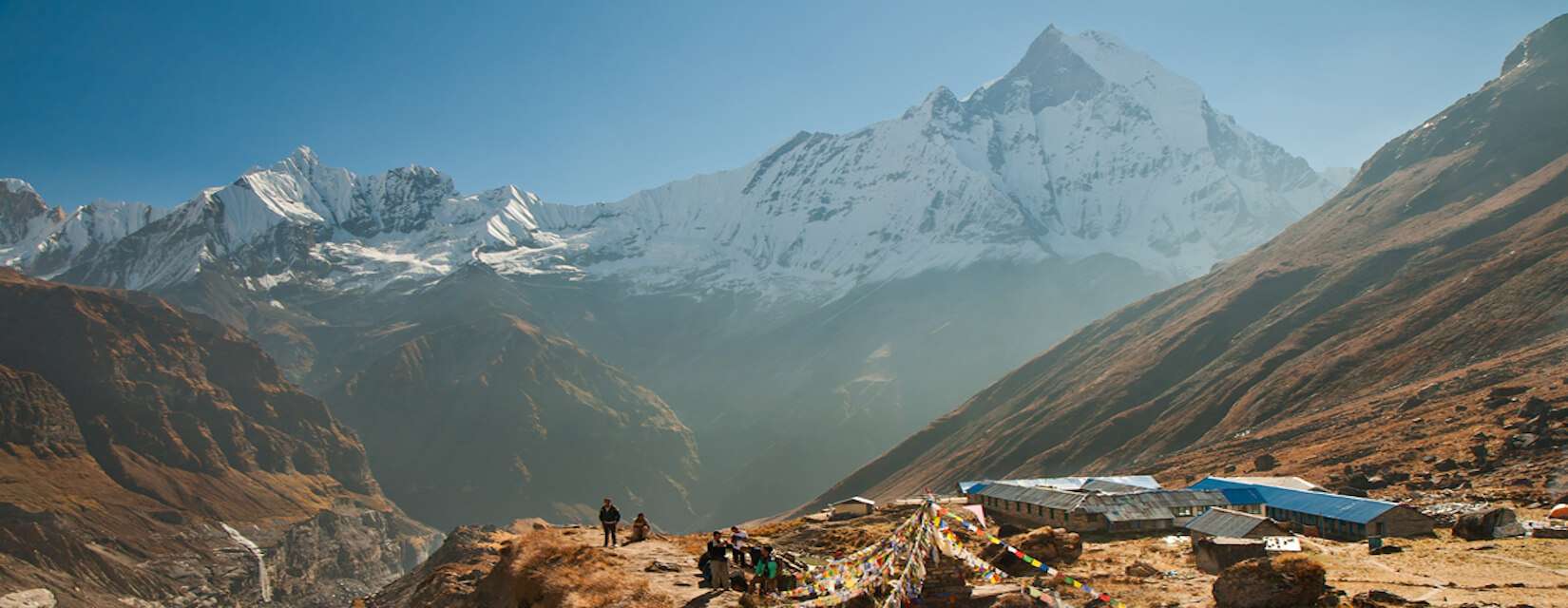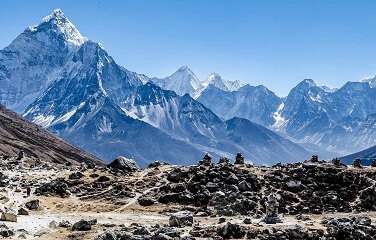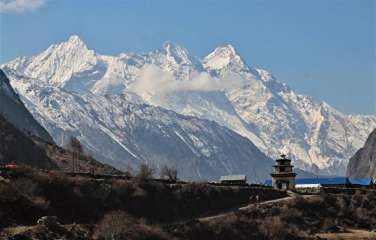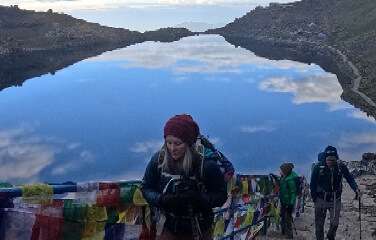Annapurna Base Camp Trek Duration
This Annapurna Base Camp Trek Duration is usually two weeks but if you have not enough holiday you can complete it within 9 days. In the Itinerary of Annapurna Base Camp Trek, you can found many different packages by different Trekking agents, but between 9 to 14 days trekking is most comfortable for you. Each day you have to walk 10 to 20 km or 6 to 7 hours during the trek. We recommend you to choose the longer packages as you get enough time to enjoy and rest the trek, but if you have limit time to trek ABC you can also options to choose Short Annapurna Base Camp Trek, it can be an exhausting and uncomfortable trekking experience. If you have hard training and good fitness then any kinds of difficulty packages you will get success.
Weather and Temperature
The major difficulty of the Himalayan trekking route is Weather and the temperature which is not constant. The Weather and Temperature of Annapurna Base Camp can change drastically and the rise and fall in the temperature are entirely based on the weather condition, altitude, and season. So you need to choose the best season to trek Annapurna Base Camp Trek.
Autumn (September To November)
Autumn (September-November) is one of the perfect seasons for trekking in Annapurna Base Camp Trek, so thousands of trekkers choose these months. In fact, September, October, and November months are will be full of excellent atmosphere as well as beauty, enjoys your journey with joy and beauty. The Autumn season provides reference weather with clear magnificent mountains. The temperature is good than another season. September-November is a great time to express your adventure in ABC Trekking. It will also be free from natural disasters such as floods and landslides these months. It's the most famous season to goes high altitude area of Himalayan.
Spring (March To May)
Spring (March-May) is the second famous trekking season in Annapurna Base Camp Trek. March, April, and May is also a great option to mountain climbing and high altitude trek. At spring morning weather condition will be clear, but the afternoon sky covered by the cloud, and sometimes can be rain. You can get to see beautiful flowers like jasmine, pine, and rhododendron with wild flora. During the Spring, lower altitude trek is mildly warm and above 3,000m quite a moderate temperature.
Summer (June To August)
In the summer season, the trekkers are less crowded in the Annapurna Base Camp Trek will be less. June, July, and August are the main raining season in Nepal which involves monsoon. Bad weather can hamper travel, maybe some problems during the journey due to heavy rain. Some travelers prefer to travel at this time as this is also not an emergency period. The weather is hot and almost every day rains.
Winter (November To March)
Winter (November-March) is also possible to trek in Annapurna Base Camp Trek, the weather condition is stable and the days are clear. December, January, and February are the cold months in Nepal. Days temperatures are cool but the nights are much cold. During the winter trek is risk winds and colder temperatures. Above 3,000m altitude being usually snowfall and freezing.
Why you need to make Right Physical Preparations
This Annapurna Base Camp trek is a classic adventure route in the Annapurna region. from starting point you have to walk through the up and down, long steps, uphill steps, and downhill steps. The trail moves up to Ghorepani, Poon Hill, and over towards the main Annapurna Base Camp bypassing the stone steep and rocky trail so you need to right train for this trip. This trek is still a moderately graded trek but not too strenuous than Everest Base Camp Trek. You must walk some steep and rugged sections and technical climbs, therefore trek demands a physically fit person.
Altitude Sickness
Annapurna Base Camp Trek takes you to 4130 meters altitude above sea level. Hike to high altitude isn’t so easy and comes several challenges. When you walk at increasing altitude then have to walk through the strenuous uphills and the air gets thinner, and come to the possibility of getting altitude sickness, so be careful and use some symptoms of altitude sickness. Similarly, you also have to keep yourself hydrated during the trek, therefore, drink enough water and avoid alcoholic drinks as it dehydrates the body. If you are planning to trek in one of the adventurous trails of Nepal then do keep the above things in your mind.
Symptoms of altitude sickness
- Difficulty in sleeping
- Dizziness or light-headedness
- Fatigue
- Headache
- Loss of appetite
- Nausea or vomiting
- Shortness of breath with exertion
Preventive measures
- Include an adequate number of rest days in the itinerary
- Keep yourself hydrated
- Do not drink alcoholic beverages
- Do not gain more than 500 meters in a day
- Try to spend the night in lower altitude
- Acclimatize properly at a lower altitude
- Inform your guide immediately if any of the symptoms you see
- Do not push yourself
Annapurna Base Camp Trek Accommodation
Annapurna base camp accommodations are Lodge and Teahouse. Around Kathmandu and Pokhara, we can find a good facility with comfortable accommodation at the Hotel. The Annapurna Base Camp Trek all accommodations are on the twin-shared basis. During the trek, Himalayan frozen Adventure will manage room with attached washrooms. In the teahouse, we have to share the toilet. Single room is available in Kathmandu, Pokhara, and the lower elevation trekking region but might be impossible to higher elevations.
Annapurna Base Camp Trek Meals
At the Kathmandu and Pokhara have included only breakfast. During the Annapurna Base Camp Trek, all meals will be provided. In the Annapurna region, we can enjoy Nepalese food with international cuisine like Tibetan, Continental, Indian, Tibetan, Italian, etc. Through the trek, we have breakfast/lunch at the teahouse and Dinner will be at the lodge. You can choices different kinds of breakfast, lunch, and dinner by the menu.
Trekking Equipment
Trekking equipment is the essential material used during the trip to the Himalayas, which is used on a daily basis. Without trekking equipment, your trip may be unsuccessful so we request you please follow the list. If you have not time to buy in your country, so don't worry we can help to buy trekking equipment in Kathmandu. Himalayan Frozen Adventure Pvt.Ltd will make your precious time reference and entertainment.
Trekking Equipment Lists
HEAD
- Headlight
- Sun hat
- Warm hat and scarf
FACE
- Face wipes and towels
- Sunscreen +40
- Sunglass
Hands
- Waterproof & Snowproof Gloves
- Lightweight gloves
Body clothing
- Sleeping bag
- Down jackets
- Sport hiking t-shirts, preferably quick-drying
- Fleece jacket and sweaters
- Poncho and rain jacket
- Socks preferably cotton –mix
- Lightweight cotton trekking pants with folding option
Lists of Footwear
- Water/Snowproof Trekking Boots
- Socks preferably cotton sports socks but take some extra pairs
- Crampon (optional)
Essential gear
- Day Backpack above the 30 L
- Pack covers
- Thermos Bottel- hard bottle that can be used for boiled drinking water
Water peals
- Umbrella / Poncho
- Walking pole if you need it
- Thick Sleeping bag
- Deodorant
- Laundry soap
- Antibacterial Gel
- Toiletries
- Toothbrush
- Shampoo
Personal accessories
- Cell phone
- Watch
- Camera
- Money wallet with Money
- Padlocks
- Plastic bag
- Sewing kit
- Extra p photos and passport photocopies
First-aid Kit
- Diamox (acetazolamide)
- Lozenges
- Elastic bandages
- Moleskin
- Cotton bandages and band-aids
- Lancing needle
- Antibiotic eye-drops
- Thermometer
- Sling
- Paracetamol
- Antiseptic antibacterial cream or solution
- Painkillers
- Anti-emetic for nausea (not at high altitude)
- Loperamide to control diarrhea
- Norfloxacin or Cipro to cure diarrhea, other infections
- Oral rehydration salts
Himalayan Frozen Adventure Pvt. Ltd porter is available for (2 trekkers a porter) who will carry up to 20 kg at maximum; therefore, keep this in mind before you pack your bags!!!






